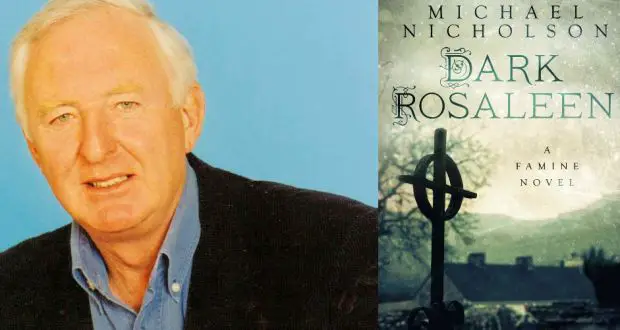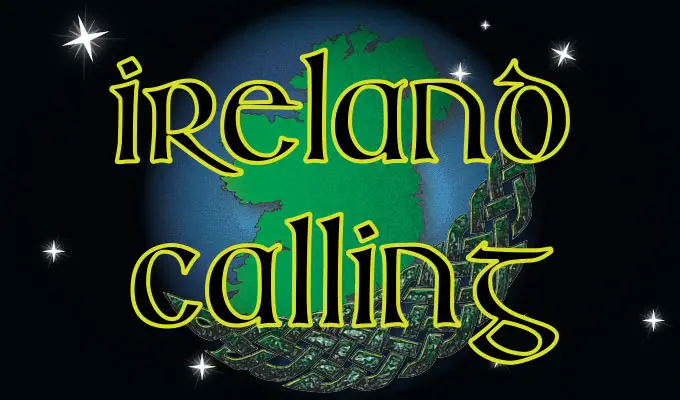One of England’s most celebrated TV reporters has described how writing a novel set during the Irish Famine made him change his mind completely about the guilt of the British government.
Mike Nicholson worked for ITN, the top commercial TV news service in the UK. His work took him to crisis spots all across the world covering wars, rebellions and famines. However, he says he never encountered anything on the scale of the Great Hunger in Ireland in the 1840s, when a million people died and as many more were forced to emigrate.

Nicholson started out thinking that the British had been blamed unfairly for what happened, but the more he researched the subject, the more convinced he became of the guilt of the British government, particularly Charles Trevelyan, the civil servant supposedly in charge of famine relief.
Nicholson has now published a novel, Dark Rosaleen, which is set in the Famine and examines the issues of what happened and who was to blame. In a personal article in the Irish Times he describes what made him research the Famine and write the novel.
“A million dead. A million fled.” It was those few words that had such an impact on me. Think of it. Try to visualise. Try putting it into a modern context, something happening today, something you are watching on television news, an apocalyptic disaster on an unheard-of scale, something that dwarfs Hiroshima.
A million dying because a foreign blight had turned a potato crop into rotten, stinking, putrefying mush. Try to picture families of living skeletons whispering their last prayer in the shelter of a ditch as they watch others turning black with the fever that spread like a summer fire across bracken from Skibbereen to Donegal, from Wicklow to Clare. Imagine another million, still untouched by it, desperately fleeing their motherland to find safety and sanctuary anywhere and with anyone who would take them. This was Ireland in the Famine years.
As a foreign correspondent for ITN, travelling the globe for more than 30 years, I reckon I have seen more than my fair share of man’s inhumanity to man. It is said that we reporters suffer from an overdose of everything, saturated as we are in the world’s woes. In places like Bangladesh, Sudan, Ethiopia, Rwanda, I became used to dealing in numbers; the dead and dying in their hundreds, or in their thousands, even their tens of thousands. But a million corpses in a forgotten corner of what was then the world’s greatest and wealthiest Empire is inconceivable.
Dark Rosaleen is the story of murder and betrayal, of a starving people held captive, of a failed rebellion and a love that grew out of it during those years of the Great Hunger.
In 1845, when the potato crop failed yet again, the British government sent a commissioner to Ireland to oversee the distribution of food aid. In my story his spoilt, overprivileged young daughter Kate is obliged to go with him to what, in her tantrums, she calls “this hateful land of saints and savages”. In her first few months, isolated in her father mansion overlooking Cork, she cares nothing for the suffering outside. Then the scale of the disaster gradually overwhelms her and her selfish arrogance turns to pity and anger. Finally, despairingly, she turns against both her father and her country. She is condemned as a traitor when she joins the rebellious Young Irelanders in their fight to end British rule.
You might think this would have been better written by an Irish author rather than an Englishman. I had a reason. At the start, my intention was to defend the government of Prime Minister Peel, to illustrate the immense physical and political problems trying to feed a starving nation across the Irish Sea. My mindset was that we English had been badly judged, that both England and Scotland were also suffering from the ravages of the blight, that communication between London and Dublin was slow and unreliable, that transporting food aid to the hinterland was a massive problem. In short, I thought there was good reason to reduce England’s blame.
I had read the famine novels of Liam O’Flaherty and Walter Macken, and was moved by their simplicity and pathos. I had listened at length to Ireland’s historical grievances in Dublin and Liverpool, in Cork and in Boston, Massachusetts, wherever Irishmen gathered over a pint of porter or a Jamesons. They spoke of a deliberate policy of imposed starvation, of land clearances, of ethnic cleansing, of exporting Irish peasants in coffin ships that might never reach the far shores of the Atlantic, and all this said as if it was proven historical fact.
Given an Irishman’s well-known considerable verbal licence I was happy to persuade myself that much of it was exaggerated blarney. But as I ploughed even deeper in my research, my characters took over and my storyline went into reverse. It was if I was a prosecuting counsel who had his side changed midway. I was a convert and I ended up with a novel I had not intended to write.
Kate is my heroine and Sir Charles Trevelyan, the government’s director of famine relief, is the villain. This is his real name and all that he does and says in my novel is as they appear, word for word, in the historical records of the time. I make this point because so much of what he said and did is barely believable.
“We will do what is necessary but no more. The Irish peasants are perverse and prefer to beg than borrow. They would rather eat free English food than labour for their own. It would be unjust and unwise to pamper them when our own people are pleading for assistance. I do not intend to transfer famine from one country to another.”
Trevelyan was guided not by any agreed government policy because there was none. He was guided by God. A pious, stubborn, uncompromising, devout evangelist, he saw the blight and the suffering as an act of Providence and to deny it was tantamount to blasphemy. The Anglo-Irish landowners, who considered the Irish peasants vermin, were loud and constant in their support and applause.
Here I must end this historical explainer for fear you will think my novel is yet another academic heavyweight. But against this background is the sequel, the story of Kate and the man who loved her, based on John Mitchel, leader of the rebellious Young Irelanders, the forefathers of Sein Féin. Kate rode with them as they preached their revolutionary gospel, as they attacked the landlords, set fire to their estates, ambushed the Redcoats and stole from the rich to feed the hungry. She became the legendary Dark Rosaleen, named after a banned nationalist poem by James Clarence Mangan.
“The Erne shall run with blood
The earth will rock beneath our tread
And flames wrap hill and wood
And gun-peal and slogan cry wake many a glen serene
Ere you shall fade, ere you should die
My Dark Rosaleen”
In order to turn history into a novel, an author is obliged to dramatise, to put words into mouths that might never have been spoken, to lay blame that perhaps was not entirely deserved. My heroine and her revolutionary lover may not have existed as I portray them. But some part of them will have lived those times and helped forge those times.
Nothing in my pages, not the people nor the lives they lived, is wholly fictional. Almost all I have written happened in real life. I have exaggerated nothing. There was no need. The truth is appalling enough and if the reader finds the descriptions of people, events and their outcome hard to believe, then go to the history books and be convinced.
Michael Nicholson has reported from 18 different war zones over a 45-year career. He was Senior Foreign Correspondent for ITN for ten years, recipient of three Royal Society Journalist of the Year Awards, one BAFTA, the Falkland and Gulf Campaign medals, and an OBE for Services to Television. Dark Rosaleen – a famine novel, is published by The History Press Ireland.
famine.html
An English View of the Irish Famine
English TV reporter Mike Nicholson wanted to write a book showing that the British government had been unfairly blamed for causing the deaths of a million people by mishandling the Irish famine. But the more he researched what happened, the more he changed his mind.
Be a friend of Ireland Calling
Falling income due to Covid is threatening our ability to bring you the best articles and videos about Ireland. A small monthly donation would help us continue writing the stories our readers love. As a thank you, we’ll email you a free gift each month you donate.
More Famine Videos
The Irish Famine – the Great Hunger
More than a million people died and another million emigrated because of the famine in Ireland in the late 1840s. But it wasn’t just a natural phenomenon. Increasingly, it is being seen as genocide by incompetent and callous government officials.
The Doolough Tragedy Video
During the Irish Famine, hundreds of desperate, starving people were forced to walk 12 miles through the cold and rain at night to get help. Many died on the way.
Tom Guerin – the Boy Buried Alive
Tom Guerin was only three years old when he was buried alive in a mass grave in Abbeystrewry near Skibbereen. Such mistakes were not uncommon in hastily arranged burials during the famine in Ireland in the 1840s.
Why Food Was Exported During the Famine
The potato crops may have failed yet Ireland was producing vast amounts of other food that could have been used to save the dying. Instead, it was shipped out of the country to be sold for profit in England.
The Deserted Vlllage of Achill Island
This deserted village on Achill Island is a sad reminder of the most tragic event in Irish history…the Great Hunger of the 1840s, sometimes referred to as the Irish Holocaust, such is the emotion it evokes.
